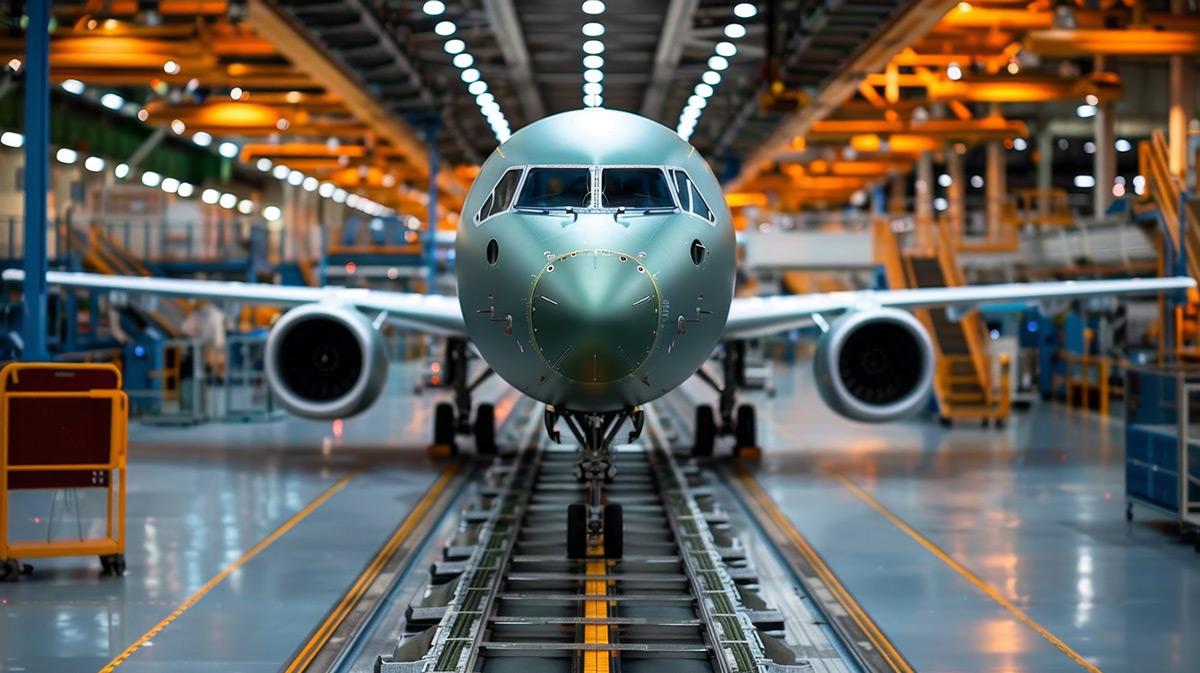CNC Machined Parts for Aerospace: Precision That Elevates
In the aerospace sector, high precision isn’t just important—it’s essential. Every part, from small brackets to major engine components, must be made with exact measurements to ensure safety, reliability, and performance.
CNC (Computer Numerical Control) machining has become the top method for creating these parts because it delivers unmatched accuracy, consistency, and efficiency. cnc machined parts for aerospace
Handles Complex Designs with Ease
Aerospace parts often have complicated designs, like curved surfaces or tiny internal features. CNC machines can handle these tricky shapes with incredible accuracy. They create thin walls, curved edges, and other detailed features with ease.
This ability helps engineers design advanced parts that work better and weigh less. CNC machining also ensures every part meets the exact specifications needed for safety and performance
Why Precision Matters in Aerospace
Safety in aerospace depends on precision. Aircraft and spacecraft operate in extreme conditions, like high speeds, heavy loads, and intense heat. Even a tiny error in a part’s size or shape can cause big problems, such as engine failure or structural damage. For example, turbine blades that aren’t perfectly shaped can disrupt airflow, making engines less efficient. Landing gear that’s not aligned correctly could fail during takeoff or landing.
CNC machining ensures every part is made to exact measurements. This accuracy helps aerospace companies avoid these risks, keeping passengers and crew safe. By removing inconsistencies, CNC machining ensures that safety standards are consistently met.
Complex Designs Made Simple
Aerospace parts often have intricate designs, like curved turbine blades, hollow structures, and thin walls. These designs help reduce weight while keeping the parts strong. Traditional methods often struggle to create such detailed shapes, but CNC machines excel at it. For instance, CNC machines can carve turbine blades with smooth aerodynamic curves that improve airflow and engine performance. These capabilities let engineers design parts that are lighter, stronger, and more efficient.
Using the Right Materials
Aerospace parts are made from materials like titanium, aluminum, and nickel-based superalloys. These materials are strong, lightweight, and built to handle tough conditions. However, they’re also difficult to work with. CNC machining uses precise cutting, drilling, and shaping techniques to handle these materials with ease. This ensures the parts meet strict aerospace standards while minimizing waste and reducing costs.
Eliminating Human Error
Precision in aerospace also means reliable manufacturing processes. Mistakes in traditional methods can happen due to human error, but CNC machines are computer-controlled, reducing this risk. Once programmed, CNC machines produce parts with consistent quality. This is especially important in aerospace, where even small mistakes can lead to serious failures. CNC machines also allow real-time monitoring to catch and fix issues before they become problems.
The Advantages of CNC Machining for Aerospace
CNC machining is incredibly precise. Once a machine is set up, it can make identical parts again and again without errors. This consistency is critical for aerospace, where even a tiny mistake can have big consequences. For example, brackets, engine mounts, and fuselage fittings all need to be identical to work together. CNC machining’s precision ensures these parts perform reliably over time.
Faster Production
CNC machines are fast and efficient. They can produce parts quickly without sacrificing quality, which is crucial when aerospace projects have tight deadlines. CNC machining is also flexible, allowing manufacturers to switch designs easily. This makes it ideal for creating prototypes or handling short production runs. Faster production helps companies save time and reduce costs.
Accelerating Aerospace Production
Tolerances are the small differences allowed in a part’s measurements. Aerospace parts often need extremely tight tolerances—as small as a thousandth of an inch. CNC machining can meet these strict requirements, making it perfect for critical components like fuel injectors and turbine blades. Tight tolerances ensure parts fit together perfectly, improving safety and reducing wear over time.
Material Flexibility
CNC machines can work with a variety of materials, making them ideal for aerospace. Different parts need different materials, like:
- Aluminum for lightweight structural parts.
- Titanium for strength and corrosion resistance.
- Nickel-based superalloys for parts that face high heat.
CNC machining handles these materials with precision, tailoring each part to its specific job.
Cost-Effectiveness
While CNC machines can be expensive to set up, they save money over time. They reduce waste by cutting materials accurately and minimize rework by producing high-quality parts the first time. Automated production also lowers labor costs. For aerospace companies, these savings help them stay competitive.
Enhanced Safety Testing
CNC machines can create parts specifically for testing, simulating real-world conditions. This allows engineers to thoroughly test designs before using them in actual aerospace projects. These tests help identify potential issues and improve safety standards. Reliable test parts also save time by making the design process more efficient.
Common Aerospace Parts Made with CNC Machining
- Turbine Blades
Turbine blades are key parts of aircraft engines. They need precise aerodynamic shapes to improve airflow and handle high temperatures. These blades also face strong rotational forces, so they must be durable. CNC machining ensures each blade meets exact specifications, improving engine performance and lifespan. With CNC machining, manufacturers can avoid extra finishing steps, saving time and resources. - Landing Gear Components
Landing gear supports an aircraft’s full weight during takeoff and landing. These parts must be strong and precise to handle repeated stress. CNC machining creates landing gear components with the exact specifications needed for safety and long-term use. The precision ensures landing gear can perform under extreme conditions without failure. Reliable landing gear is critical for every flight. - Brackets and Fittings
Brackets and fittings may seem simple, but they’re essential for holding aircraft parts together. They must fit perfectly into complex assemblies to maintain the aircraft’s structure. CNC machining produces these parts with precise measurements, ensuring they perform reliably. The accuracy of these components supports the overall strength and stability of the aircraft. - Engine Components
Aircraft engines are made of many detailed parts, like housings, nozzles, and fuel injectors. Each piece must work perfectly to keep the engine running efficiently. CNC machining’s precision is essential for creating these critical components. High-quality engine parts improve fuel efficiency and reduce maintenance needs, keeping aircraft reliable. - Aerostructures
Aerostructures, such as wing panels and fuselage sections, must be lightweight yet strong. These parts often have intricate designs to improve aerodynamics and reduce drag. CNC machining ensures these components meet exact specifications, enhancing fuel efficiency and safety. Precise machining also reduces weak points, making the aircraft more durable and environmentally friendly. - Electrical Housing
Modern aircraft depend on advanced electrical systems. CNC machining creates housings that protect these systems from extreme conditions like vibration and heat. These housings also shield sensitive electronics from environmental factors. By using CNC machining, manufacturers can create reliable housings that ensure the long-term functionality of critical systems.
Materials Commonly Used in Aerospace CNC Machining
Titanium
Titanium is strong, lightweight, and doesn’t rust, making it perfect for aerospace machined parts. However, it’s a tough material to work with because it’s very hard and gets hot when machined. CNC machines use special tools and cooling systems to cut titanium accurately. These tools prevent overheating and ensure parts stay precise. Titanium is often used for structural components and engine parts that need to handle heavy loads and extreme conditions.
Aluminum
Aluminum is lightweight and strong, which is why it’s widely used in aerospace. It’s also easy to machine and resists corrosion, making it a favorite material for many projects. CNC machining produces aluminum parts quickly while maintaining smooth finishes and tight tolerances. Common aluminum components include wings, brackets, and internal parts where lightweight design is essential. Its strength-to-weight ratio and cost-effectiveness make it a go-to material for many aerospace applications.
Nickel-Based Superalloys
Nickel-based superalloys are built to withstand extreme heat, making them ideal for turbine blades and exhaust systems. These materials are very strong but also difficult to machine. CNC machines use precise tools to shape these alloys without losing their strength. These superalloys are essential for parts that experience both high temperatures and heavy stress. Using CNC machining reduces waste, which is especially important because these high-quality materials are expensive.
Stainless Steel
Stainless steel is strong, resists rust, and can handle a lot of stress, making it great for aerospace parts like fasteners and hydraulic systems. It’s commonly used for structural components that need both durability and precision. CNC machines cut stainless steel to exact measurements, ensuring the parts perform well under tough conditions. The smooth surface finishes produced by CNC machining reduce friction and extend the lifespan of these parts. Stainless steel is also used in areas where the parts need to look good, like aircraft interiors.
Composites
Composites combine strength with a lightweight design, making them perfect for aerospace. These materials are often used for wings and interior components. Machining composites requires special care to avoid cracks or damage. CNC machines make precise cuts and smooth edges, keeping the material intact. This precision allows for innovative designs that improve aerodynamics and reduce the overall weight of the aircraft.
Key Benefits of CNC Machining in Aerospace
Aerospace parts need smooth surfaces to reduce drag and improve performance. CNC machines produce high-quality finishes that save time because they don’t need extra polishing. Smooth surfaces also help parts last longer by reducing wear and tear. For parts like wings or turbine blades, this precision improves efficiency and cuts down on maintenance. High-quality finishes are one of the reasons CNC machining is so valuable in aerospace.
Scalable Production
CNC machining is flexible and can handle both small and large production runs. This means it’s great for making a single prototype or thousands of identical parts. Manufacturers can easily adjust the number of parts needed without losing quality. This scalability is especially useful for aerospace companies working on custom projects or tight deadlines. Whether making one part or many, CNC machining delivers consistent results in aerospace part production.
Reduced Lead Times
CNC machines automate much of the production process, which speeds things up. This is crucial in aerospace, where meeting deadlines is often critical. By reducing setup time and machining parts faster, CNC machines help projects stay on track. Faster lead times also mean important components can be delivered quickly. This efficiency keeps aerospace companies competitive.
Improved Durability
Parts made with CNC machining are not only precise but also durable. This is important in aerospace, where components face tough conditions like high pressure and extreme temperatures. CNC machining’s accuracy ensures that parts are made to last, reducing the need for frequent replacements. Durable parts save time and money while also improving the safety and reliability of the aircraft. Long-lasting components are a key benefit of using 5-axis CNC machines in aerospace.
Finding the Best CNC Machined Parts for Aerospace
CNC machining has changed aerospace manufacturing by making it possible to produce parts with incredible precision and consistency. From turbine blades to fuselage panels, CNC machines create components that meet strict safety and performance standards. Their ability to work with different materials and handle complex designs makes them essential in the aerospace industry.




